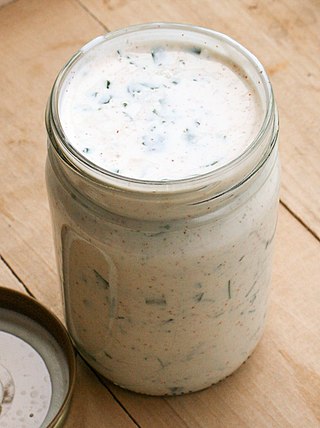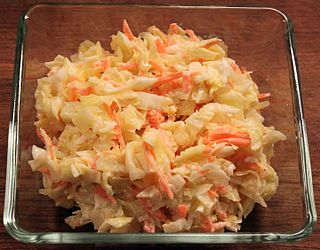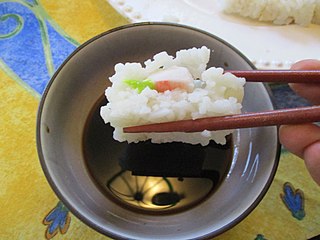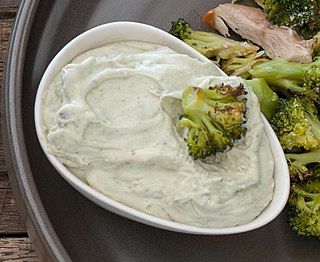
A Caesar salad is a green salad of romaine lettuce and croutons dressed with lemon juice, olive oil, eggs or egg yolks, Worcestershire sauce, anchovies, garlic, Dijon mustard, Parmesan cheese, and black pepper.

In cooking, a sauce is a liquid, cream, or semi-solid food, served on or used in preparing other foods. Most sauces are not normally consumed by themselves; they add flavor, moisture, and visual appeal to a dish. Sauce is a French word taken from the Latin salsa, meaning salted. Possibly the oldest recorded European sauce is garum, the fish sauce used by the Ancient Romans, while doubanjiang, the Chinese soy bean paste is mentioned in Rites of Zhou in the 3rd century BC.

A salad is a dish consisting of mixed ingredients, frequently vegetables. They are typically served chilled or at room temperature, though some can be served warm. Condiments and salad dressings, which exist in a variety of flavors, are often used to enhance a salad.

Ranch dressing is a savory, creamy American salad dressing usually made from buttermilk, salt, garlic, onion, mustard, herbs, and spices mixed into a sauce based on mayonnaise or another oil emulsion. Sour cream and yogurt are sometimes used in addition to, or as a substitute for, buttermilk and mayonnaise.

Coleslaw, also known as cole slaw, or simply as slaw, is a side dish consisting primarily of finely shredded raw cabbage with a salad dressing or condiment, commonly either vinaigrette or mayonnaise. This dish originated in the Netherlands in the 18th century. Coleslaw prepared with vinaigrette may benefit from the long lifespan granted by pickling.

A dip or dip sauce is a common condiment for many types of food. Dips are used to add flavor or texture to a food, such as pita bread, dumplings, crackers, chopped raw vegetables, fruits, seafood, cubed pieces of meat and cheese, potato chips, tortilla chips, falafel, and sometimes even whole sandwiches in the case of jus. Unlike other sauces, instead of applying the sauce to the food, the food is typically placed or dipped into the sauce.

Blue cheese dressing is a popular side sauce, salad dressing and dip in the United States and Canada. It is usually made of some combination of blue cheese, mayonnaise, and buttermilk, sour cream or yogurt, milk, vinegar, onion powder, and garlic powder. There is a blue cheese vinaigrette that consists of salad oil, blue cheese, vinegar, and sometimes seasonings.

Wish-Bone is an American brand of salad dressing, marinades, dips and pasta salad. The original salad dressing was based on a recipe served at the Wishbone restaurant in Kansas City, Missouri, founded by ex-soldier Phillip Sollomi in 1945 along with Lena Sollomi, Phillip's mother. The Italian dressing served at the Wishbone was based on a recipe from Lena Sollomi's Sicilian family which was a blend of oil, vinegar, herbs and spices. Demand for the salad dressing proved so high that Phillip started a separate operation to produce it for sale, making it by the barrel. The brand was acquired by Lipton, part of the Unilever portfolio, in 1958, and was manufactured in the Kansas City area. In 2013, Pinnacle Foods acquired Wish-Bone from Unilever. In turn, ConAgra acquired Pinnacle Foods on October 26, 2018.

Pasta salad is a salad dish prepared with one or more types of pasta, almost always chilled, and most often tossed in a vinegar, oil, or mayonnaise-based dressing. It is typically served as an appetizer, side dish or a main course. Pasta salad is often regarded as a spring or summertime meal, but it can be served any time of year.

Chinese chicken salad is a salad including chopped chicken and Chinese culinary ingredients that is common in parts of the United States. Though many variations exist, common features of Chinese chicken salads include lettuce, cabbage, carrots, cucumbers, chicken, deep-fried wonton skins or rice vermicelli and nuts. A basic vinaigrette for the salad includes ingredients like vegetable oil, sesame oil, rice vinegar. Optional seasonings include dry hot mustard, sesame seeds, coriander and raw ginger or pickled ginger. In restaurants, Chinese chicken salad may be more embellished and offered as an American-style entree salad, similar to Caesar, Chef, and Cobb salads.

Vinaigrette is made by mixing an oil with a mild acid such as vinegar or lemon juice. The mixture can be enhanced with salt, herbs and/or spices. It is used most commonly as a salad dressing, but can also be used as a marinade. Traditionally, a vinaigrette consists of 3 parts oil and 1 part vinegar mixed into a stable emulsion, but the term is also applied to mixtures with different proportions and to unstable emulsions which last only a short time before separating into layered oil and vinegar phases.

The McDonald's Premium line is a group of products introduced by McDonald's in the spring of 2003. It includes the company's larger chicken sandwiches, its salad line, and its coffee products. The sandwiches are targeted at various demographic markets, the grilled chicken sandwiches and salads are targeted at both the female and health-conscious demographic markets. The entire line is intended to bring in a larger, more affluent, adult audience seeking better quality products.

Seven-layer salad is an American dish that includes a colorful combination of seven layers of ingredients: iceberg lettuce, tomatoes, cucumbers, onions, sweet peas, hard-boiled eggs, sharp cheddar cheese, and bacon pieces. The salad is topped with a mayonnaise-based dressing and sometimes sour cream is added. It is often served in a glass bowl or large pan so the layers can be observed. The dish is often associated with potlucks, picnics, and barbecues, where a large gathering of people takes place and many people need to be fed. There are many variants of the seven-layer salad and it can be made with additional layers, making it an eight-layer salad instead.

In the United States, a haystack is a dish composed of a starchy food topped by a protein, in combination with fresh vegetables, and garnished with various condiments. Haystacks are conceptually like a deconstructed tostada. The haystacks ingredients are served individually and assembled on the plate by the person who will be eating it.

The cuisine of Chiapas is a style of cooking centered on the Mexican state of the same name. Like the cuisine of rest of the country, it is based on corn with a mix of indigenous and European influences. It distinguishes itself by retaining most of its indigenous heritage, including the use of the chipilín herb in tamales and soups, used nowhere else in Mexico. However, while it does use some chili peppers, including the very hot simojovel, it does not use it as much as other Mexican regional cuisines, preferring slightly sweet seasoning to its main dishes. Large regions of the state are suitable for grazing and the cuisine reflects this with meat, especially beef and the production of cheese. The most important dish is the tamal, with many varieties created through the state as well as dishes such as chanfaina, similar to menudo and sopa de pan. Although it has been promoted by the state of Chiapas for tourism purposes as well as some chefs, it is not as well known as other Mexican cuisine, such as that of neighboring Oaxaca.
















